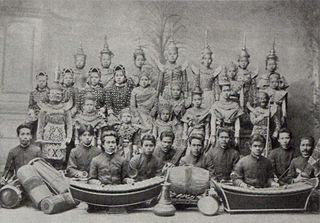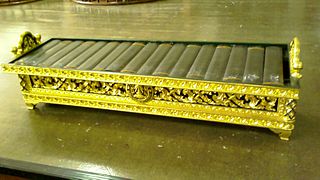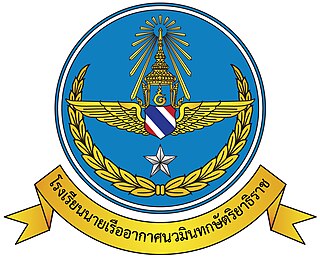
The music of Thailand includes a wide array of distinct genres, both traditional and modern.

A metallophone is any musical instrument in which the sound-producing body is a piece of metal, such as tuned metal bars, tubes, rods, bowls, or plates. Most frequently the metal body is struck to produce sound, usually with a mallet, but may also be activated by friction, keyboard action, or other means.

A piphat is a kind of ensemble in the classical music of Thailand, which features wind and percussion instruments. It is considered the primary form of ensemble for the interpretation of the most sacred and "high-class" compositions of the Thai classical repertoire, including the Buddhist invocation entitled sathukan as well as the suites called phleng rueang. It is also used to accompany traditional Thai theatrical and dance forms including khon, lakhon, and shadow puppet theater.

Wong khrueang sai is a musical ensemble in Thai classical music which consists primarily of string instruments. A typical khrueang sai ensemble features two two-string fiddles, one high and one low, a three-string zither called jakhe, a vertical duct flute called khlui, hand drums, and various cymbals. Depending on the size of the ensemble, instruments may be doubled or left out. A three-string spike fiddle called saw sam sai may be added as well. The khim has become popular and is also used in this ensemble. In the 20th century, Western instruments such as the violin or organ have also occasionally been integrated into khrueang sai ensembles.

A crystallophone is a musical instrument that produces sound from glass.

The ranat ek lek is a metallophone used in the classical music of Thailand. It is the smaller of the two sizes of Thai metallophone; the larger one is called ranat thum lek.

The ranat thum lek is a metallophone used in the classical music of Thailand. It is the larger of the two sizes of Thai metallophone; the smaller one is called ranat ek lek.

The khlui is a vertical duct bamboo flute from Thailand, which originated before or during the Sukhothai period (1238–1583). It was officially recognized as a Thai instrument by King Trailokkanat (1431–1488), who set the official model of each traditional Thai instrument. It is generally made of bamboo, though instruments are also made from hardwood or plastic. After many generations of modifications, it survives to the present day in three main forms: the khlui phīang aw, khlui lip, and khlui ū, which are of different sizes. The khlui is very similar to the Cambodian khloy.
Struck idiophones is one of the categories of idiophones that are found in the Hornbostel-Sachs system of musical instrument classification.

The Overture is a 2004 Thai tragic-nostalgia music-drama film. A fictionalised account based on the life story of Thai palace musician Luang Pradit Phairoh, it follows the life of a Thai classical musician from the late 19th century to the 1940s. The film was the winner of several awards in Thailand and was the country's official selection for the Academy Award for Best Foreign Language Film. It was directed by Itthisoontorn Vichailak, who also co-wrote the script, and producers included Nonzee Nimibutr and Chatrichalerm Yukol. The film was also credited with a revival in the popularity of piphat – Thai classical music. In 2015, this film was remade into a musical play from the 4th of April to 17 May at KBank Siam Pic-Ganesha Theatre.
Traditional Thai musical instruments are the musical instruments used in the traditional and classical music of Thailand. They comprise a wide range of wind, string, and percussion instruments played by both the Thai majority as well as the nation's ethnic minorities.

The pong lang is a xylophone from the Isan region of northeast Thailand. The instrument may be played as a standalone instrument, in pairs with one player playing melody and the other harmonizing, or as part of an orchestra. Players use carved two hardwood mallets.
The ranat kaeo is a crystallophone consisting of struck glass bars of varying length, used in the classical music of Thailand. It is usually played with a soft padded mallet.

The ranat thum is a low pitched xylophone used in the music of Thailand. It has 18 wooden keys, which are stretched over a boat-shaped trough resonator. Its shape looks like a ranat ek, but it is lower and wider. It is usually played in accompaniment of a ranat ek.

The ranat ek is a Thai musical instrument in the percussion family that consists of 22 wooden bars suspended by cords over a boat-shaped trough resonator and struck by two mallets. It is used as a leading instrument in the piphat ensemble.

The roneat dek is a Cambodian metallophone, comparable to the Roneat ek. It is an ancient instrument made of 21 blackened-iron bars. It may be used in the Pinpeat ensemble and Mahaori orchestra. It is believed to have originated from the Royal Courts before the Angkor period. This instrument is rarely covered with ornamentation on either the bars or the sound box. The roneat dek is analogous to the ranat ek lek of Thailand.

The roneat thung or roneat thum is a low-pitched xylophone used in the Khmer classical music of Cambodia. It is built in the shape of a curved, rectangular boat. This instrument plays an important part in the Pinpeat ensemble. The roneat Thung is placed on the left of the roneat ek, a higher-pitched xylophone. The Roneat Thung is analogous to the ranat thum of Thai.

The Navaminda Kasatriyadhiraj Royal Air Force Academy (NKRAFA) is a military academy for officer cadets of the Royal Thai Air Force.
















